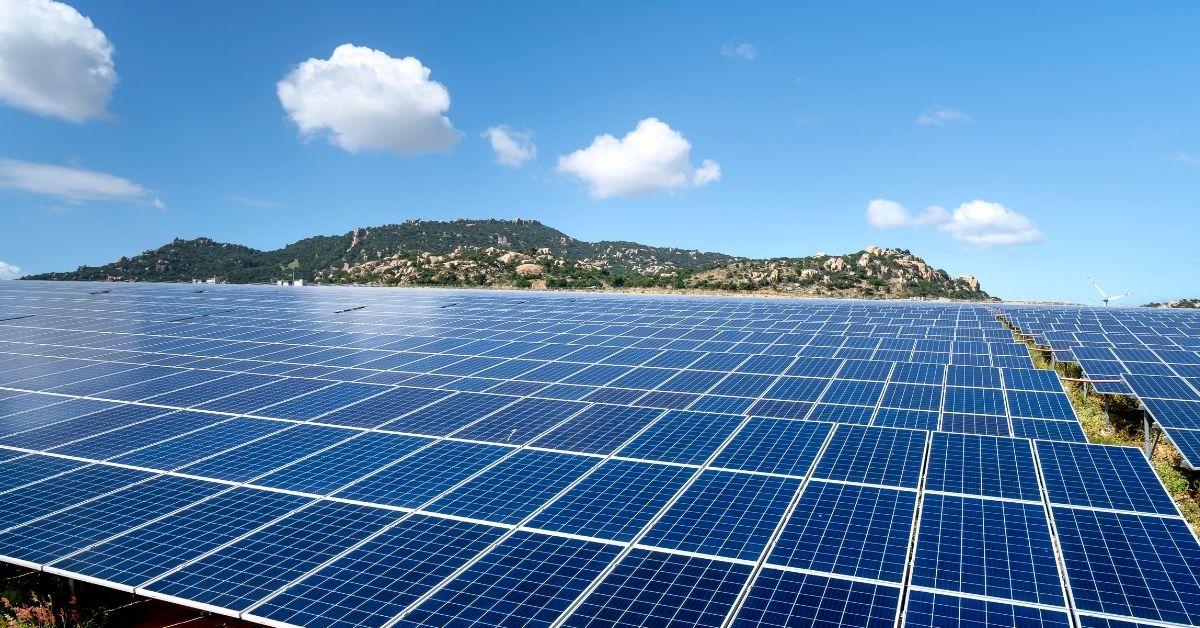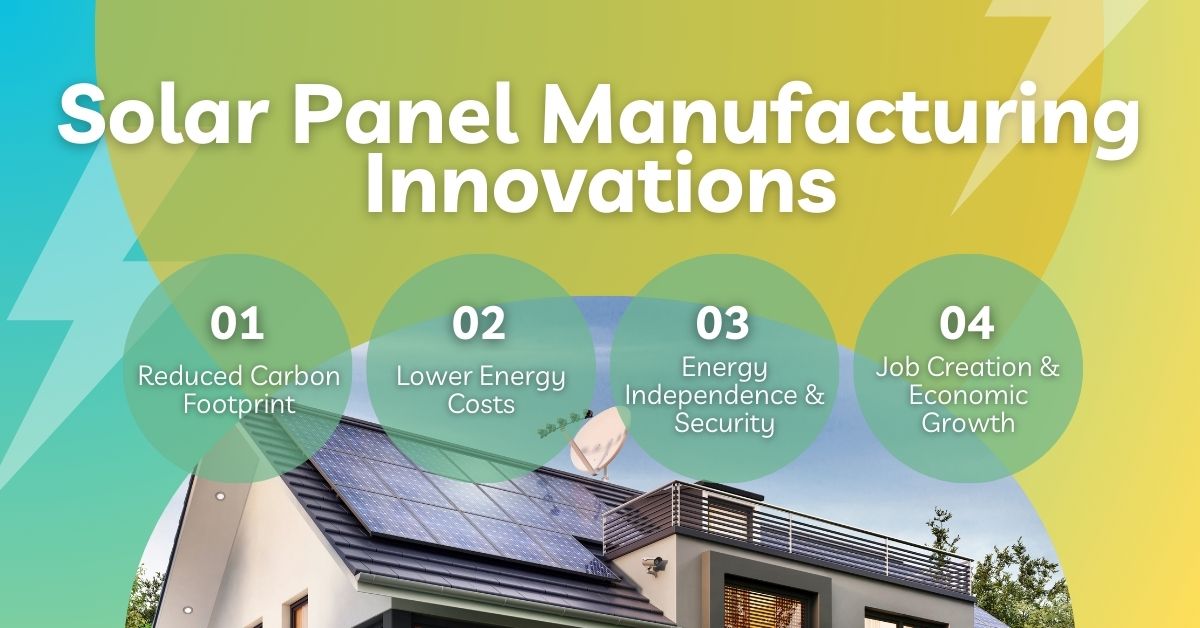Solar Panel Manufacturing Innovations
Solar Panel Manufacturing Innovations focuses on increasing efficiency, reducing costs, and enhancing sustainability. Breakthroughs in perovskite and bifacial solar cells allow for greater energy capture, even in low-light conditions.
Automated, AI-driven manufacturing processes streamline production, reducing human error and material waste. New materials, such as ultra-thin, flexible substrates, enable lightweight, versatile panels for varied applications. Additionally, the adoption of sustainable practices, including recycling and the use of eco-friendly materials, reduces the environmental footprint of production. These innovations promise to make solar energy more accessible, efficient, and scalable, accelerating the global transition to renewable energy sources.
Solar Panel Manufacturing Innovations
Table of Contents:
- Introduction
- The Growing Need for Solar Energy
- The Role of Manufacturing in Solar Energy Development
- Traditional Solar Panel Manufacturing
- Overview of Standard Manufacturing Processes
- Key Materials Used in Solar Panels
- Challenges in Traditional Manufacturing
- Innovative Materials in Solar Panel Production
- Perovskite Solar Cells
- Bifacial Solar Panels
- Organic Photovoltaics (OPVs)
- Advanced Manufacturing Techniques
- 3D Printing in Solar Manufacturing
- Roll-to-Roll Manufacturing
- Thin Film Technology
- Automation and Robotics in Solar Panel Production
- The Role of Automation in Reducing Costs
- Precision and Efficiency with Robotics
- Case Studies of Automation in Factories
- Sustainability in Solar Panel Manufacturing
- Reducing Waste in Production
- Recycling and Circular Economy Practices
- Environmentally Friendly Manufacturing Processes
- Efficiency Improvements in Solar Panels
- Higher Efficiency Solar Cells
- Concentrated Photovoltaic Technology
- Quantum Dot Solar Cells
- Integration of AI and Machine Learning
- AI-Driven Design Optimization
- Predictive Maintenance with Machine Learning
- AI in Supply Chain and Production Management
- Global Trends in Solar Panel Manufacturing
- Geopolitics of Solar Manufacturing
- The Rise of Local Manufacturing Hubs
- Technological Partnerships and Collaborations
- Challenges and Future Outlook
- Overcoming Material Shortages
- Grid Integration Challenges
- Future Directions in Solar Manufacturing
- Conclusion
- The Path Forward for Solar Panel Manufacturing
1. Introduction
The Growing Need for Solar Energy
With global energy demands increasing and the effects of climate change becoming more pronounced, solar energy offers a sustainable solution. As more countries commit to reducing carbon emissions, the demand for efficient and affordable solar technology is rising.

The Role of Manufacturing in Solar Energy Development
While solar energy production is well-understood and accessible, the manufacturing processes behind solar panels are crucial to making this technology both economically viable and scalable. Advances in solar panel manufacturing can lower costs, increase efficiency, and reduce environmental impact. Thus, innovation in this space is critical for the widespread adoption of solar energy.
2. Traditional Solar Panel Manufacturing
Overview of Standard Manufacturing Processes
Solar panels are traditionally made from crystalline silicon wafers, which are processed through a series of steps, including slicing, cleaning, and doping to create photovoltaic (PV) cells. These cells are then interconnected and encapsulated between layers of glass or polymer to form a durable solar panel.
The conventional manufacturing process involves energy-intensive steps such as the purification of silicon, which requires high temperatures and significant amounts of electricity. This raises both the cost of production and the carbon footprint of the manufacturing process.
Key Materials Used in Solar Panels
The primary material used in traditional solar panels is silicon. Silicon’s abundance and semi-conductive properties make it ideal for converting sunlight into electricity. However, silver, copper, aluminum, and various polymers are also critical in the construction of solar panels, making material sourcing and cost management a significant factor in the manufacturing industry.
Challenges in Traditional Manufacturing
Traditional manufacturing processes face several challenges. The high energy consumption required to produce silicon wafers makes the process expensive and energy-intensive. Additionally, there are environmental concerns related to the chemicals and waste generated during production. Improving these processes is crucial for the future of solar energy.
3. Innovative Materials in Solar Panel Production
Perovskite Solar Cells
Perovskite solar cells have recently gained attention for their potential to revolutionize solar technology. These cells use perovskite-structured materials that offer several advantages over traditional silicon-based cells, including a higher efficiency rate and lower production costs. One of the key benefits of perovskite solar cells is their ability to capture a broader spectrum of light, allowing for greater energy conversion.
However, the main challenge for perovskite cells is their durability, as they tend to degrade more quickly than silicon cells. Researchers are working on improving the longevity and stability of these cells to make them a viable commercial option.
Bifacial Solar Panels
Bifacial solar panels are designed to capture sunlight from both sides of the panel, increasing their energy-generating potential. These panels are especially effective in areas with high albedo surfaces, such as snow or white rooftops, as they can absorb the reflected sunlight from below.
The manufacturing of bifacial solar panels requires innovations in materials and design to ensure that both sides of the panel are equally effective at capturing sunlight. With advancements in glass and polymer technology, bifacial solar panels are becoming more cost-effective and efficient.
Organic Photovoltaics (OPVs)
Organic Photovoltaics (OPVs) represent another frontier in solar panel innovation. These solar cells use organic molecules or polymers to absorb sunlight and convert it into electricity. While they are not as efficient as silicon-based solar panels, OPVs offer unique advantages such as flexibility, lightweight properties, and the potential for low-cost, large-scale production.
Because OPVs can be printed onto flexible substrates, they offer the possibility of integrating solar technology into various surfaces, such as clothing or portable electronics. This makes them highly adaptable for different applications, even though they are still in the developmental phase for widespread commercial use.
4. Advanced Manufacturing Techniques
3D Printing in Solar Manufacturing
3D printing technology is being explored in solar panel manufacturing to produce components with higher precision and reduced material waste. With the ability to print intricate designs and custom geometries, 3D printing can help optimize the layout of solar cells, leading to higher efficiency and cost savings.
Moreover, additive manufacturing allows for rapid prototyping, enabling manufacturers to experiment with different materials and designs at a lower cost and in a shorter timeframe. This could accelerate the development of new solar technologies.
Roll-to-Roll Manufacturing
Roll-to-roll (R2R) manufacturing is a continuous production process used for creating flexible solar panels. This method involves depositing thin layers of photovoltaic materials onto flexible substrates, such as plastic or metal foils, as they pass through various processing stations.
R2R manufacturing is particularly beneficial for producing large quantities of solar cells at a lower cost. It enables faster production speeds and minimizes material usage, making it an attractive option for producing flexible or thin-film solar panels.
Thin Film Technology
Thin-film solar panels are made by depositing a thin layer of photovoltaic material, such as cadmium telluride or copper indium gallium selenide (CIGS), onto a substrate. These panels are typically lighter, more flexible, and easier to install than traditional silicon-based panels.
The manufacturing process for thin-film technology is less energy-intensive compared to crystalline silicon panels, and it allows for a broader range of applications. However, improving the efficiency of thin-film solar cells remains a key challenge.
5. Automation and Robotics in Solar Panel Production
The Role of Automation in Reducing Costs
Automation plays a critical role in driving down the cost of solar panel production. By automating various stages of the manufacturing process, such as silicon wafer cutting, cell assembly, and quality control, manufacturers can reduce labor costs, increase production speed, and improve consistency.

Automation also helps in minimizing human error, which can lead to defective panels. With machines handling precision tasks, manufacturers can achieve higher yields and reduce waste.
Precision and Efficiency with Robotics
Robotics in solar panel manufacturing allows for highly precise assembly and installation. Robots equipped with sensors can handle delicate tasks, such as placing photovoltaic cells onto panels or soldering connections, with greater accuracy than human workers.
Moreover, robots can operate continuously without fatigue, leading to increased efficiency and higher output in factories. Some solar panel manufacturers are already using robots in their production lines, resulting in faster production times and reduced labor costs.
Case Studies of Automation in Factories
Several companies have embraced automation and robotics in their manufacturing processes. For example, Tesla’s Gigafactory employs automation to produce solar panels at scale. By using robotic arms for assembly and quality control, Tesla has been able to produce high volumes of panels while keeping costs low.
Another example is First Solar, which uses advanced automation technologies to manufacture thin-film solar panels. Through the use of robotics, First Solar has been able to achieve high throughput and efficiency in its production process.
6. Sustainability in Solar Panel Manufacturing
Reducing Waste in Production
One of the key challenges in solar panel manufacturing is minimizing waste. Traditional processes often generate significant amounts of scrap materials, particularly when cutting silicon wafers. Manufacturers are now focusing on reducing waste by optimizing production techniques and recycling excess materials.
For example, some companies are developing methods to recycle silicon waste and reuse it in the production of new wafers, thus reducing the need for raw materials and lowering production costs.
Recycling and Circular Economy Practices
Recycling is becoming an essential aspect of sustainable solar panel manufacturing. As more solar panels reach the end of their life cycle, finding ways to recycle the components has become increasingly important. Silicon, glass, and metals used in solar panels can be recovered and repurposed, contributing to a circular economy.
Several companies are investing in recycling technologies that can efficiently separate and recover materials from decommissioned solar panels. This not only helps reduce the environmental impact of solar energy but also supplies materials for new panel production.
Environmentally Friendly Manufacturing Processes
In addition to recycling, manufacturers are exploring ways to make their production processes more environmentally friendly. This includes reducing energy consumption during manufacturing, using renewable energy sources in factories, and minimizing the use of harmful chemicals.
Some companies are even experimenting with green manufacturing techniques, such as using organic solvents and biodegradable materials in the production of solar panels. These efforts aim to lower the carbon footprint of solar panel manufacturing and create a more sustainable industry.
7. Efficiency Improvements in Solar Panels
The Higher Efficiency Solar Cells
Improving the efficiency of solar cells is a top priority for researchers and manufacturers. Higher-efficiency cells can convert more sunlight into electricity, making solar panels more cost-effective and space-efficient.
Several innovations are contributing to higher efficiency, including multi-junction solar cells that use multiple layers of materials to capture different wavelengths of sunlight, and passivated emitter rear contact (PERC) technology, which improves light absorption and reduces energy losses.
Concentrated Photovoltaic Technology
Concentrated Photovoltaic (CPV) technology uses lenses or mirrors to focus sunlight onto highly efficient solar cells. This allows for the generation of more electricity from a smaller area of solar cells, making CPV systems highly efficient.
While CPV technology is more complex and expensive than traditional solar panels, it offers significant advantages in areas with high direct sunlight, such as deserts. Ongoing research is focused on making CPV systems more affordable and practical for widespread use.
Quantum Dot Solar Cells
Quantum dot solar cells are an emerging technology that uses nanoscale semiconductor particles to capture and convert sunlight into electricity. These solar cells have the potential to achieve very high-efficiency rates and can be manufactured at a lower cost than traditional silicon-based cells.
Quantum dots can be tuned to absorb different wavelengths of light, making them highly versatile. While still in the experimental stage, quantum dot solar cells could represent the next breakthrough in solar panel efficiency.
8. Integration of AI and Machine Learning
AI-Driven Design Optimization
Artificial intelligence (AI) is being used to optimize the design of solar panels. By analyzing vast amounts of data on solar cell performance, AI can identify the best materials, layouts, and configurations for maximizing efficiency.
AI algorithms can also simulate different environmental conditions, such as temperature and shading, to determine how solar panels will perform in various settings. This allows manufacturers to design panels that are tailored to specific climates and locations.
Predictive Maintenance with Machine Learning
Machine learning algorithms are being applied to monitor the performance of solar panels in real time. By analyzing data from sensors installed on solar panels, machine learning can predict when a panel is likely to fail or require maintenance.
This predictive maintenance approach helps reduce downtime and extend the lifespan of solar panels. It also enables manufacturers and solar farm operators to schedule maintenance more efficiently, minimizing costs and disruptions.
AI in Supply Chain and Production Management
AI is also being used to optimize supply chain management and production processes in solar panel manufacturing. By analyzing data on material availability, production schedules, and demand forecasts, AI can help manufacturers streamline their operations and reduce costs.
For example, AI can predict supply chain disruptions and suggest alternative suppliers or production schedules, ensuring that manufacturers can meet demand without delays. This is particularly important in the solar industry, where material shortages and production bottlenecks can significantly impact costs.
9. Global Trends in Solar Panel Manufacturing
Geopolitics of Solar Manufacturing
The global solar manufacturing industry is shaped by geopolitics, with countries like China, the U.S., and Germany leading the market. China’s dominance in solar panel production has raised concerns about supply chain dependencies, prompting other nations to invest in local manufacturing capabilities.
Trade policies, tariffs, and international agreements also play a significant role in shaping the global solar manufacturing landscape. As countries seek to reduce their reliance on foreign suppliers, there is a growing emphasis on developing local solar manufacturing industries.
The Rise of Local Manufacturing Hubs
In response to the geopolitical challenges of relying on a few major manufacturers, countries around the world are investing in local manufacturing hubs. For example, the U.S. government has introduced incentives for domestic solar panel production, aiming to reduce dependence on imports and create jobs in the renewable energy sector.
Similarly, the European Union has launched initiatives to build local solar manufacturing capacities, particularly in regions with high solar potential. This shift towards localized production is expected to reduce transportation costs and lower the carbon footprint of solar panels.
Technological Partnerships and Collaborations
Collaboration between governments, research institutions, and private companies is driving innovation in solar panel manufacturing. Many of the advancements in materials, manufacturing techniques, and efficiency improvements are the result of partnerships between different sectors.
For example, research institutions are working with manufacturers to develop new materials, while government programs provide funding and support for pilot projects. These collaborations are crucial for bringing new technologies to market and making solar energy more accessible.
10. Challenges and Future Outlook
Overcoming Material Shortages
One of the biggest challenges facing the solar manufacturing industry is the availability of critical materials. Silicon, silver, and rare metals used in solar panels are subject to supply chain disruptions and price volatility. As demand for solar panels grows, finding sustainable and reliable sources of these materials will become increasingly important.

Grid Integration Challenges
As solar energy becomes a larger part of the global energy mix, integrating solar power into existing electricity grids poses challenges. Solar energy is intermittent, depending on sunlight availability, and traditional grids were not designed to handle the variability of renewable energy sources. Innovations in energy storage and grid management technologies will be critical for addressing these challenges.
Future Directions in Solar Manufacturing
The future of solar panel manufacturing is likely to be shaped by continued innovation in materials, manufacturing techniques, and efficiency improvements. As technology advances, solar panels will become more affordable, efficient, and sustainable. Integration with energy storage systems, such as batteries, will also play a key role in the widespread adoption of solar energy.
Conclusion
Solar panel manufacturing innovations are paving the way for a cleaner, more sustainable future. Advances in materials, production techniques, and efficiency are driving down costs and making solar energy more accessible. As the world transitions to renewable energy, the role of solar panel manufacturing will continue to grow in importance, helping to meet the global demand for clean, affordable power.
The future of solar energy looks bright, and with continued innovation, solar panel manufacturing will remain at the forefront of the renewable energy revolution.
Click Here to Learn More Solar Panel Manufacturing Innovations

